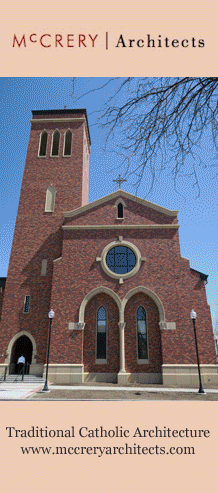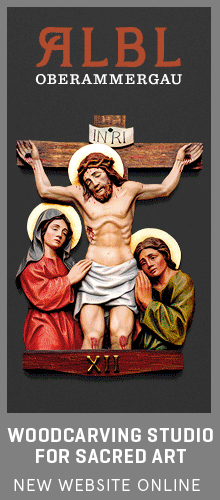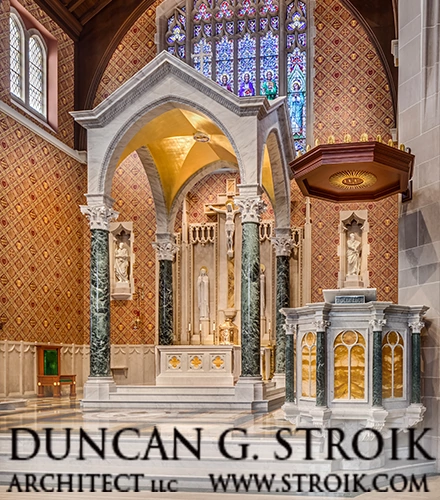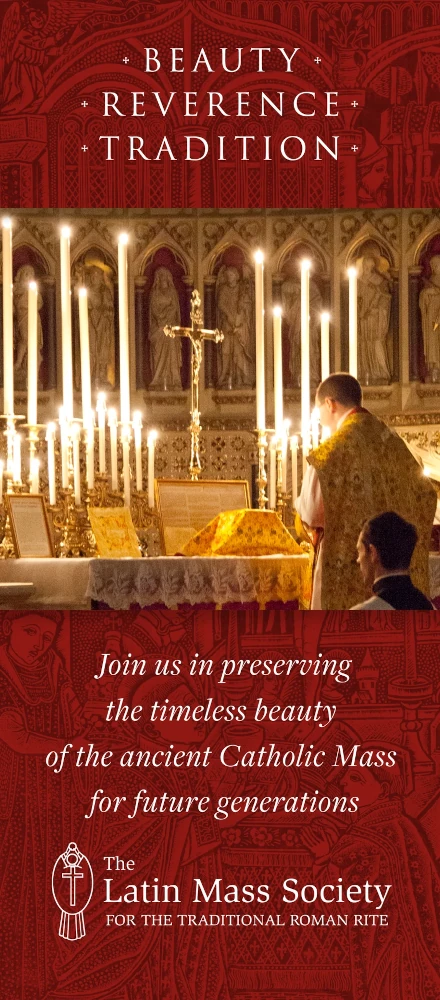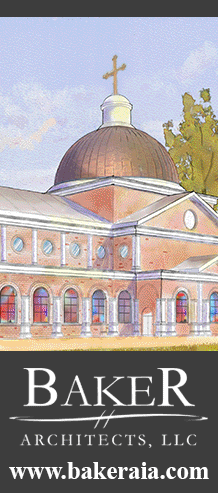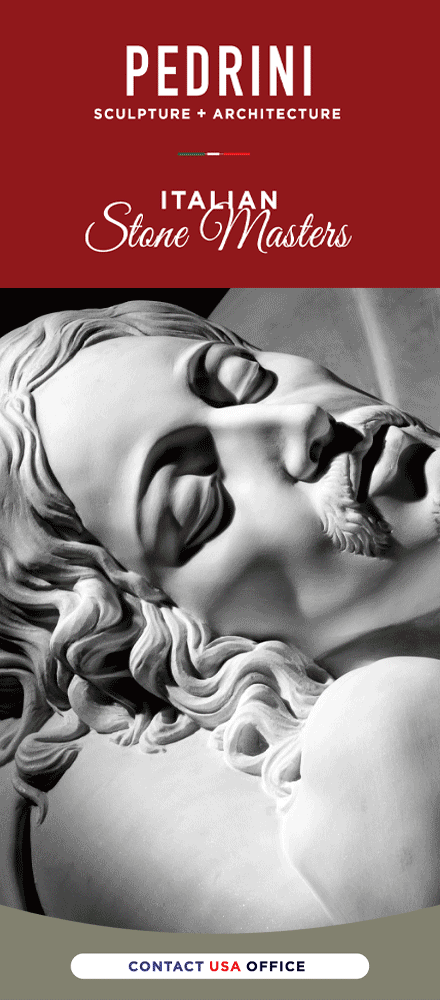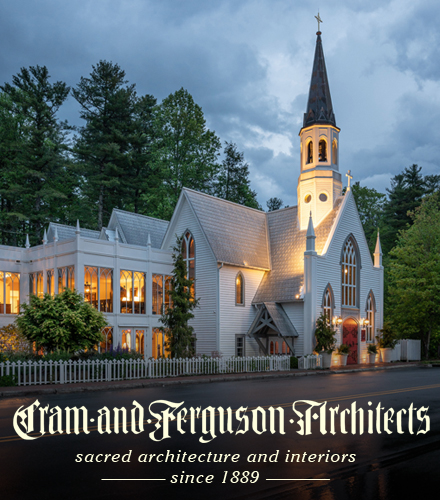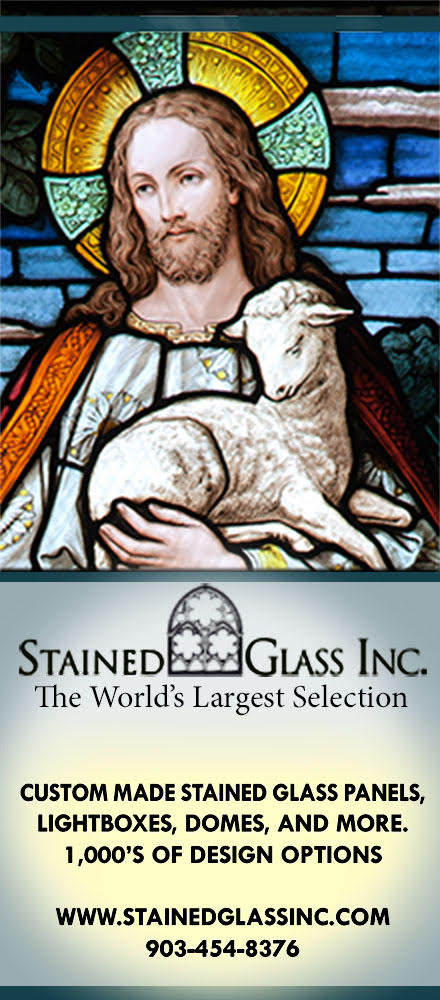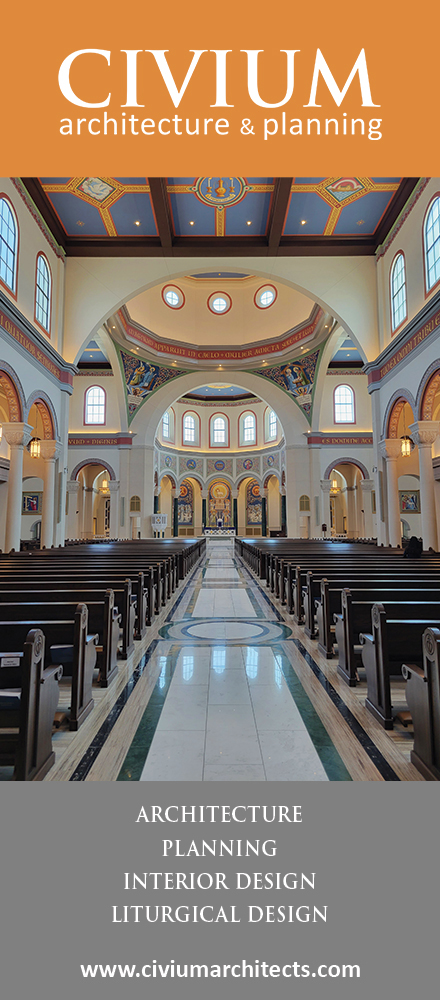The annual issue of Sacred Architecture Journal was posted recently. It has some interesting looking offering's if you get the magazine, including a piece on "Pugin in America" and also a piece on Holy Transfiguration Skete (a nice picture can be seen here).
Available online is this editorial by Duncan Stroik:
Editorial: VENITE ET VIDEBITIS
By Duncan Stroik
The more the Church grew into the Eucharistic mystery, the more she understood that she could not consummate the celebration of Communion within the limited time available in the Mass.—Benedict XVI
What is it that makes a Catholic church different from other churches? I remember asking myself this question as a graduate student in architecture school. On a cold and dreary day I visited the Dominican church of St. Mary in New Haven. What is it that would draw people in to make a visit, say a prayer, or even stay for a while in this massive Gothic pile? Huge stairs challenged me to come in. “There is something important up here,” they seemed to say. Upon entry, the architecture was generous, grand, and with a sense of the beautiful. The lofty and colorful vaulted nave and side aisles with their bundled colonnettes and stained glass were complex and offered a glimpse into a shadowy mystery.
Musty smells, lingering incense, flickering candles, and imagery made me aware of the sacredness of the place. Elements such as side altars, statues, paintings, stations of the cross, wood confessionals, and pews seemed familiar even though I had never seen them before. I was moved by the beautiful and strange works of art. I felt I was in the Father’s house and I felt safe, cared for, and a bit in awe.
Later, a fellow student told me that what differentiates a Catholic church from all other churches is that God is present there at all times: in the Eucharist, reserved in the tabernacle. This was a novel thought to me, having grown up going to contemporary multipurpose churches where the reserved Eucharist was hidden away and housed in a brass box. I asked a priest I respected whether what distinguished a Catholic house of God from other churches was that God was truly present in the reserved host. He told me no. But I continued to wonder why some Catholic churches seemed so holy.
At the recent Synod on the Eucharist in Rome, the bishops expressed concern that people do not have correct faith in the Real Presence of Christ in the Holy Eucharist. How much has this lack of belief been caused by the design of modern churches and the treatment of the tabernacle?
Joseph Cardinal Ratzinger in his book God is Near Us: The Eucharist, the Heart of Life writes, “During the day our churches should not be allowed to be dead houses, standing empty and seemingly useless.” Our churches are not to be used simply for an hour a day, but they are places of prayer and we should fill them. The devout Simeon, who was waiting to see the salvation of Israel, and the prophetess Anna, who worshipped in the temple night and day, rejoiced at Christ’s presentation in the Temple. They would be jealous of us who have the opportunity to be in his presence every day.
Pope Benedict sees our churches as calling us and inviting us in. Jesus Christ beckons to us through art, architecture, and material goods to enter in and worship. The oval piazza of St. Peter in Rome is one of the finest examples of how the exterior of the church building can be an invitation to the mysteries inside. Gian Lorenzo Bernini, responsible for the design, wrote that “since the church of St. Peter is the mother of nearly all the others it had to have colonnades, which would show it as if stretching out its arms maternally to receive Catholics, so as to confirm them in their faith, heretics, to reunite them to the Church, and infidels, to enlighten them in the true faith.” The house of God should beckon us, draw us in, and offer us an image of the eternal and real presence of the Lord. This should be done by employing the time tested principles of sacred architecture rather than with the profane aesthetic and commercial tricks of shopping centers, country clubs, or multiplexes.
Pope Bendedict again: “Jesus Christ’s invitation is always being proffered from [our churches]. This sacred proximity to us is always alive in them. It is always calling us and inviting us in. This is what is lovely about Catholic churches, that within them there is, as it were, always worship, because the Eucharistic presence of the Lord dwells always within them.” This worship continues outside of the liturgy, and we should participate in that worship through prayer, adoration, and by honoring Christ through noble and beautifully designed tabernacles and their surroundings. It was for this reason that St. Charles Borromeo, among others, advocated the enlargement and centrality of the holy tabernacle and its joining with the Eucharistic altar at the Basilica of St. Mary Major in Rome and in the cathedral and churches of the archdiocese of Milan. The eternal flame or sanctuary lamp hanging near the tabernacle is the sign of the fire of love that dwells within this miniature temple. The worship of Christ present is also articulated by other types of iconography: praying angels, images of the saints and martyrs who offered their bodies towards Christ’s one sacrifice. The saints and angels along with the faithful of all lands are part of that worship. The heavenly host and the heavenly banquet have historically been represented in our churches—a thesis recently articulated in Denis McNamara’s brilliant new book, Heavenly City: The Architectural Tradition of Catholic Chicago.
So even when the historic architecture of other Christian traditions is inspiring or even imitates the splendors of two millennia of Catholic tradition, it is the Eucharist reserved that sets apart the Catholic church or chapel as a sacred place. This is why people cross themselves as they pass a church, why they genuflect as they enter their seats, and kneel to pray in Christ’s presence. If the theological truth of God’s real presence in the tabernacle is believed by the faithful and church architecture reflects the fact that we are in the presence of the Almighty then it will cause us to rethink how we comport ourselves in church, how we relate to others and show reverence for Him who offered himself on the cross. The Lord is always there:
"When, thus, the eternal light was lit in the Church, and the tabernacle installed beside the altar, then it was as if the bud of the mystery had opened, and the Church had welcomed the fullness of the Eucharistic mystery. The Lord is always there. The church is not just a space in which something sometimes happens early in the morning, while for the rest of the day it stands empty, ‘unused’. There is always the ‘church’ in the church building, because the Lord is always giving himself, because the Eucharistic mystery remains present, and because we, in approaching it, are always included in the worship of the whole believing, praying and loving Church." (Benedict XVI [Joseph Ratzinger], God is Near)
Wednesday, July 26, 2006
Sacred Architecture Journal: Issue 11, 2006
Shawn TribeMore recent articles:
Do Priests or Religious Need Special Permission to Pray a Pre-55 Breviary?Peter Kwasniewski
On occasion, I receive an email like the following (in this case, from a seminarian): “Do you happen to know of any sources/authoritative references which you could point me to that explain why praying the Pre-55 Breviary definitely satisfies the canonical obligation for clerics or religious? As I am strongly desirous of the Pre-55 Liturgy, I ...
Early Bird Registration Discount for CMAA Colloquium Ends March 31st!Jennifer Donelson-Nowicka
Join us this summer for world-class training in the Church’s treasury of sacred music.Early bird registration discount ($50 for colloquium, $50 for Vocal Intensive course, $150 off for Chant Intensive) ends March 31st!Here’s a special invitation from our new president, Fr. Robert Pasley.The Church Music Association of America is pleased to announc...
The Annunciation 2025: Dante and the Virgin MaryGregory DiPippo
The specific date of birth of the great poet Dante Alighieri (1265-1321) is unknown, but this Thursday, March 27th, is the anniversary of his baptism, which took place during the Easter vigil of 1266. The language which we call “Italian” today originated as the dialect of his native region of Tuscany (more specifically, of the city of Florence, but...
The Messenger AngelMichael P. Foley
Anonymous, the Archangel Gabriel, depicted on the predella of the high altar at the subsidiary church of Pesenbach, Upper Austria, 1495In the traditional Roman calendar, the feast days of saints are sometimes clustered together to form archipelagos of holiness that allow the faithful to meditate longer on a sacred mystery. These archipelagos do not...
The Third Sunday of Lent 2025Gregory DiPippo
At that time: Jesus was casting out a devil, and the same was dumb: and when he had cast out the devil, the dumb spoke: and the multitudes were in admiration at it: But some of them said: He casteth out devils by Beelzebub, the prince of devils. And others tempting, asked of him a sign from heaven. But he seeing their thoughts, said to them: Every ...
Pictures of Montecassino AbbeyGregory DiPippo
Following up on yesterday’s post of pictures of the crypt of Montecassino Abbey, here are some of the main church and some of the things around it, starting with the most important part of it, the burial site of St Benedict and his sister St Scholastica, behind the high altar.As I am sure our readers know, Montecassino Abbey was heavily bombed duri...
The Prodigal Son in the Liturgy of LentGregory DiPippo
In his commentary on the Gospel of St Matthew, St Jerome writes as follows about the parable of the two sons who are ordered by their father to go and work in the vineyard (21, 28-32). “These are the two sons who are described in Luke’s parable, the frugal (or ‘virtuous’) and the immoderate (or ‘wanton’).” He then connects these two sons with the f...
Another Chant for the Byzantine Liturgy of the PresanctifiedGregory DiPippo
Now the powers of heaven invisibly worship with us, for behold, the King of Glory entereth! Behold, the mystical sacrifice, being perfected, is carried forth in triumph. With faith and love, let us come forth, that we may become partakers of eternal life, Alleluia, Alleluia, Alleluia! (Recording by the Lviv Archeparchial Clergy Choir.) Нині сили ...
The Crypt of Montecassino AbbeyGregory DiPippo
For the feast of St Benedict, here are some pictures of the crypt of the abbey of Montecassino, the site where he ended his days. The crypt was built in the early 16th century, and originally decorated with frescoes, but by the end of the 19th century, these had deteriorated so badly from the humidity that they were deemed unsalvageable. The decisi...
An Interview with Fr Uwe Michael Lang on LiturgyGregory DiPippo
I am sure that our readers will enjoy this interview with the liturgical scholar Fr Uwe Michael Lang of the London Oratory, which was recently published on the YouTube channel of the Totus Tuus Apostolate. It covers a wide range of subjects: Pope Benedict’s teaching on the liturgy, the liturgical abuses in the post-Conciliar period and our own time...


